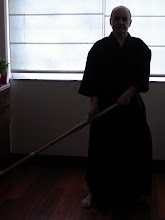#1 Aikido 合気道
Aikido is a Japanese Martial Art created during the 1920s by Morihei Ueshiba (1883~1969), an expert who reached the highest level of mastery in the classical Japanese Martial Arts. Aikido is performed by blending with the motion of the attacker and redirecting the force of the attack rather than opposing it head-on. Aikido has not competition. The goal of Aikido training is not perfection of a step or skill, but rather improving one's character according to the rules of nature.
#2 Judo 柔道
Judo means "The Gentle Way" in Japanese. Contrary to the meaning, Judo is competitive and intense. Jigoro Kano created Judo in 1882. Throwing, taking down, striking and some offensive techniques are used in Judo. But Kano's way is not only getting techniques to win, but cultivating their personalities. Probably Judo is the most famous martial arts in Japan because it's an athletic event of Olympic games.
#3 Kendo 剣道
Kendo 剣道 is a modern Japanese martial art, which descended from swordsmanship (kenjutsu) and uses bamboo swords (shinai) and protective armour (bōgu). Today, it is widely practiced within Japan and many other nations across the world.
Kendo is an activity that combines martial arts practices and values with strenuous sport-like physical activity.Kendo is the result of transformation from the tool to kill each other to the way to learn techniques and develop their mental thing.
Kendo is an activity that combines martial arts practices and values with strenuous sport-like physical activity.Kendo is the result of transformation from the tool to kill each other to the way to learn techniques and develop their mental thing.
#4 Iaido 居合道
Iaido 居合道, abbreviated with iai 居合, is a modern Japanese martial art/sport. Iaido is associated with the smooth, controlled movements of drawing the sword from its scabbard or saya, striking or cutting an opponent, removing blood from the blade, and then replacing the sword in the scabbard. While beginning practitioners of iaido may start learning with a wooden sword (bokken) depending on the teaching style of a particular instructor, most of the practitioners use the blunt edged sword, called iaitō. Few, more experienced, iaido practitioners use a sharp edged sword (shin ken). Iaido is a very rare in the way that it consists of the flow which start to sit to ending to sheathe a sword.
#5 Karate 空手
Karate 空手 is a martial art developed on the Ryukyu Islands in what is now Okinawa, Japan. It developed from the indigenous martial arts of Ryukyu Islands under the influence of Chinese martial arts, particularly Fujian White Crane.Karate is now predominantly a striking art using punching, kicking, knee strikes, elbow strikes and open hand techniques such as knife-hands, spear-hands, and palm-heel strikes. Historically and in some modern styles grappling, throws, joint locks, restraints, and vital point strikes are also taught. A karate practitioner is called a karateka 空手家. Karate has the rank certification and colored belts differ depending on the organizations. Usually black belt is the highest rank.
#6 Kyudo 弓道
Kyudo 弓道 is the Japanese martial art of archery. Bow and arrow which used in Kyudo were the weapons of the Samurai. As time went by, it had gotten be ceremonial and popular. A series of motions to shoot an arrow is important to hit the target. It always needs to have a calm mind.
Kyudo is different from other martial arts in that an opponent is not a human but a target. Therefore you can enjoy yourself.If your arrow couldn't pierce a target, the cause is arising from you. It makes you to consider yourself and develop your mind.
